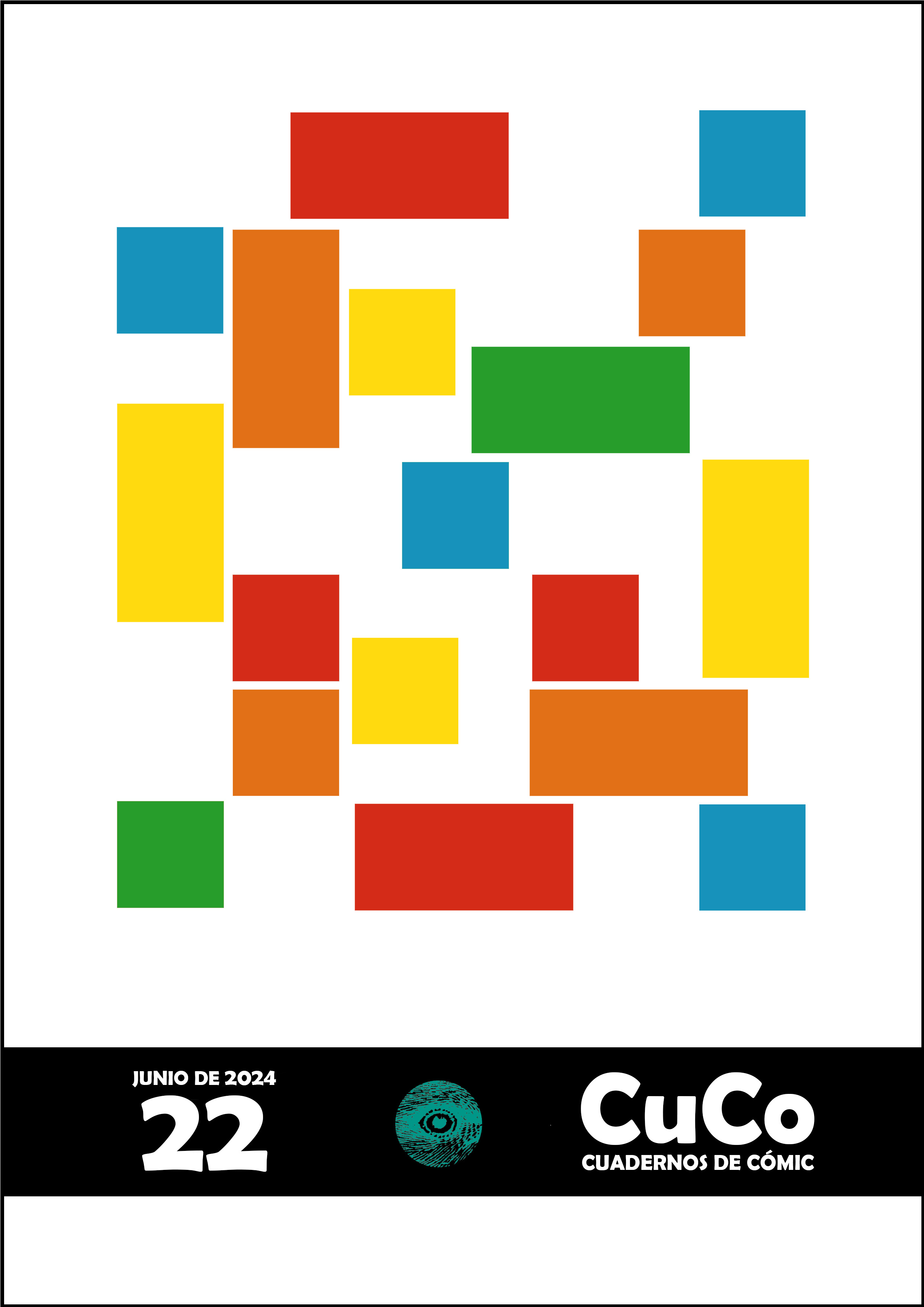Published 2024-07-08
Keywords
- Comic,
- onomatopoeia,
- paleontology,
- dinosaurs,
- speculative fiction
How to Cite
Copyright (c) 2024 Charlie Charmer, Iván Narváez Padilla

This work is licensed under a Creative Commons Attribution-ShareAlike 4.0 International License.
Abstract
Onomatopoeia is a fundamental expressive resource in comics that synthesizes text and image. Its main function is to represent inarticulate sounds foreign to language, such as animal voices. When dealing with extinct creatures without a sound record, such as dinosaurs and other Mesozoic fauna, onomatopoeia takes on a speculative dimension whose concreteness depends on the imagination of both the author and the reader. The most common technique is to use contemporary references, but there are also more personal works that have created their own universe.
Downloads
References
- BEARES, O. «La grafía en la historieta: evolución de la combinación de texto y dibujo en los orígenes y primer desarrollo del cómic», en CuCo, Cuadernos de Cómic, nº 1 (2013), pp. 63-90. https://doi.org/10.37536/cuco.2013.1.1064
- — «La grafía en la historieta: modos, lugares y estética», en CuCo, Cuadernos de Cómic, nº 2 (2014), pp. 31-52. https://doi.org/10.37536/cuco.2014.2.1322
- BENAYOUN, R. Le ballon dans la bande dessinée. París, André Balland, 1968.
- CHARMER, C. El Comicsaurio. Málaga, Applehead Team, 2021.
- CLARKE, J. et al. «Fossil evidence of the avian vocal organ from the Mesozoic», en Nature, 538 (2016) pp. 502-505. https://doi.org/10.1038/nature19852
- CONTENTO, W.G. «Index to Science Fiction Anthologies and Collections, Combined Edition» (última actualización: 18 de marzo de 2015). Disponible en: http://www.philsp.com/resources/isfac/0start.htm
- CRUZ CABANILLAS, I. DE LA y TEJEDOR MARTÍNEZ, C. «La influencia de las fórmulas inarticuladas, interjecciones y onomatopeyas inglesas en tebeos españoles», en Revista de lingüística y lenguas aplicadas, n.º 4 (2009), pp. 47-58. http://doi.org/10.4995/rlyla.2009.734
- DEFOREST, T. Storytelling in the Pulps, Comics, and Radio: How Technology Changed Popular Fiction in America. Jefferson (NC), McFarland, 2004.
- GASCA, L. y GUBERN, R. Diccionario de onomatopeyas del cómic. Madrid, Cátedra, 2008.
- GUBERN, R. «La onomatopeya es imprescindible en el cómic», en el «Suplemento Cultural» de ABC de 14 de marzo (2009). Disponible en: http://culturacomiquera.files.wordpress.com/2009/06/cultural-14-03-2009-pagina-0542.pdf
- HABIB, M.B. «Dawn of the Din», en Scientific American, n.º 326 (2022), pp. 42-47.
- HOLT, J. y FUKUDA, T. «‘The Power of Onomatopoeia in Manga’, an Essay by Natsume Fusanosuke with Translators' Introduction», en Japanese Language and Literature, n.º 56 (2022), pp. 157-184. https://doi.org/10.5195/jll.2022.170
- LÓPEZ SANJUAN, O. Hace un millón de años: Todo el cine de dinosaurios. Madrid, Diábolo Ediciones, 2020.
- METCALF, G. «“If You Read It, I Wrote It”: The Anonymous Career of Comic Book Writer Paul S. Newman», en The Journal of Popular Culture, n.º 29 (1995), pp. 147-162. https://doi.org/10.1111/j.0022-3840.1995.2901_147.x
- MYHRVOLD, N. P., y CURRIE, P. J. «Supersonic sauropods? Tail dynamics in the diplodocids», en Paleobiology, 23 (1997), pp. 393-409. https://doi.org/10.1017/S0094837300019801
- PEÑA MÉNDEZ, M. «La desesperante levedad de la consideración artística. Procesos y retrocesos en la artificación del cómic», en Papeles de cultura contemporánea, 22 (2019), pp. 9-36. https://doi.org/10.30827/pcc.v0i22.15604
- RAE y ASALE (ed.). Diccionario de Americanismos. Madrid, Santillana, 2010.
- REDONDO REYES, P. «Onomatopeya, imitación y poesía en Grecia y Roma», en Studia Philologica Valentina, n.º 21 (2019), pp. 209-229. Disponible en: https://www.uv.es/sphv/21/12_SPhV_21_Redondo_209-229.pdf
- RIEDE, T. et al. «Coos, booms, and hoots: The evolution of closed-mouth vocal behavior in birds», en Evolution, vol.70, n.º 8 (2016), pp. 1734-1746. https://doi.org/10.1111/evo.12988
- SAFFI, S. «Chants et cris d’animaux: corpus d’onomatopées et de verbes français et italiens», en Italies, n.º 12 (2008), pp. 173-190. https://doi.org/10.4000/italies.1240
- USILLOS RUIZ, A. Las pequeñas palabras y su traducción: glosario trilingüe de onomatopeyas (español-inglés-francés) [Trabajo de Fin de Grado]. Universidad de Valladolid, 2018. Disponible en: https://uvadoc.uva.es/bitstream/handle/10324/33979/TFG-O-1429.pdf?sequence=1
- VV. AA. Cambridge Academic Content Diccionary. Cambridge University Press, 2008.
- VV. AA. Los hijos de Pulgarcito. Bilbao, Astiberri, 2004.
- VALERO GARCÉS, C. «Análisis comparativo del uso y traducción de formas inarticuladas y formas onomatopéyicas en cómics y tebeos», en MOSKOWICH, I. et al. (coord.) Some Sundry Wits Gathered Together. A Coruña, Universidade da Coruña, Servizo de Publicacións, 1997, pp. 227-236.
- WEISHAMPEL, D.B. «Acoustic Analyses of Potential Vocalization in Lambeosaurine Dinosaurs (Reptilia: Ornistichia)», en Paleobiology, vol.7, n.º 2 (1981), pp. 252-261. https://doi.org/10.1017/S0094837300004036
- YLÄ-OUTINEN, L. Les onomatopées anglaises introduites en français par la bande dessinée [Trabajo de Fin de Máster]. Universidad de Jyväskylä, 2013. Disponible en: https://jyx.jyu.fi/bitstream/handle/123456789/41228/URN:NBN:fi:jyu-201304221475.pdf
- YOSHIDA, J., KOBAYASHI, Y. y NORELL, M. A. «An Ankylosaur Larynx Provides Insights for Bird-like Vocalization in Non-avian Dinosaurs», en Communications Biology, n.º 6, 152 (2023). https://doi.org/10.1038/s42003-023-04513-x

